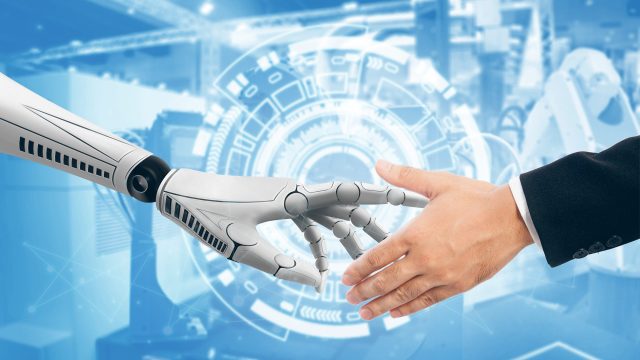Le cluster Human Experience in Manufacturing & Industry 4.0 organise une journée d’étude sur la collaboration homme-machine le mardi 11 juillet 2023 dans l’Amphithéâtre S de École Centrale de Nantes, 1 rue de la Noë. Cet évènement est ouvert à tous. Inscrivez-vous ICI.
Programme
13h45 – Accueil café
14h – Introduction par Toinon VIGIER et Damien CHABLAT
14h15 – Human Machine Collaborative Decision-Making in Manufacturing & Industry 4.0 par Liang MA, Professeur à l’Institut des facteurs humains et de l’interaction homme-machine, Université Tsinghua, Pékin
15h15 – Introduction of a Cobot as Intermittent Haptic Contact Interfaces in Virtual Reality par Damien CHABLAT, Directeur de recherche CNRS
15h45 – Pause café
16h – Les enjeux de l’utilisation des exosquelettes dans le milieu du travail par Benoît SAGOT-DUVAUROUX, Responsable activité Gobio, Europe Technologies group
16h30 – Étude de la transparence de manipulateurs passifs par approches mécaniques et cognitives : application aux systèmes de Neoditech et leurs utilisations par Thomas MULLER, Chef de projet recherche et développement, Neoditech
17h – Conclusion par Toinon VIGIER et Damien CHABLAT
14h15 – Human Machine Collaborative Decision-Making in Manufacturing & Industry 4.0
With the increasing power and the rapid deployment of machine intelligence, more and more scenarios in Manufacturing & Industry 4.0 require human-machine collaborative decision-making (HMCD). In this talk, we are going to share our thinking on the new issues raised in HMCD under the context of manufacturing and propose a conceptual framework to address those issues. The following ongoing research projects and their preliminary results in our lab would be covered.
1. Organizational issues: the shifting relationship between humans and machines from supervisor-subordinator to partnership and its influence in sequential risk decision-making. We conducted experiments and explored the changing role of the machine and its influence on sequential decision-making behavior.
2. Modeling methods: modeling the maneuver and the decision-making of a pilot’s landing operation in man-machine hybrid scenes in a data-driven manner. Driven by the data from landing operations, we used an influence diagram model considering the latent state of humans and observable states of machines to predict the pilot’s sequential decision-making.
3. Operational issues: increasing workload while using imperfect machines. We conducted an experiment to measure the operator’s workload while working with machines with different algorithm performances.
15h15 – Introduction of a Cobot as Intermittent Haptic Contact Interfaces in Virtual Reality
Virtual reality (VR) is evolving and being used in industrial simulations, but the possibility to touch objects is missing, for example, to judge the perceived quality in the design of a car. Current haptic interfaces do not make it possible to easily restore texture, therefore an approach is considered as an intermittent contact interface to achieve this. A cobot places a moving surface at the point of contact with a virtual object in order to enable physical contact with the hand of the operator. This paper aims to speak about several challenges: the placement of the robot, the modeling of the operator, the management of the displacement and the speed of the robot, and the detection of the operator’s intentions. The placement of the robot is chosen to allow reaching the different working areas and to ensure passive safety by making it impossible for the robot to hit the head and chest of the operator in a normal working position, i.e. sitting in a chair. A user model, consisting of a torso and arms, is designed and tested to track the user’s movements in real-time. Interaction is possible with a set of pre-defined poses that the user follows together as desired. Various strategies are proposed to predict the intent of the user. The main aspects of prediction are based on the direction of the eye and the position of the hand of the user. An experimental study as well as the resulting analysis demonstrates the contribution by considering the direction of the gaze. The advantage of introducing “safety” points to move the robot away from the operator and allow rapid movements of the robot is emphasized.
16h – Les enjeux de l’utilisation des exosquelettes dans le milieu du travail
Dans cette présentation, nous ferons un tour d’horizon des produits et des marchés de l’industrie des exosquelettes avant d’aborder les apports et les risques liés à leur utilisation, l’adaptation au poste de travail, à l’opérateur ou à l’individu au travers d’exemples concrets, et les pistes de développement envisagées.
16h30 – Étude de la transparence de manipulateurs passifs par approches mécaniques et cognitives : Application aux systèmes de Neoditech et leurs utilisations
Cette présentation traite de la caractérisation de la transparence de manipulation de système passifs d’aide à la manutention de charges. Ces systèmes sont utilisés pour manipuler des charges de 10 à 100 kg où ils permettent de réduire considérablement les troubles musculosquelettiques. Ils constituent une technologie d’avenir dont il est important de caractériser la transparence de manipulation de manière holistique afin d’étudier l’interaction homme/machine. Nous analysons de manière théorique les manipulateurs, puis nous développons une approche expérimentale de mesure mécanique et cognitive. Cette analyse mettant en avant une redondance des mesures, nous en déduisons un protocole simplifié d’évaluation des manipulateurs que nous appliquons au dernier manipulateur conçu par l’entreprise. Nous concluons alors quant à une modélisation globale de la transparence de manipulation et aux moyens de l’améliorer. Nous décrirons également les cas d’applications passés et futures de nos manipulateurs.



